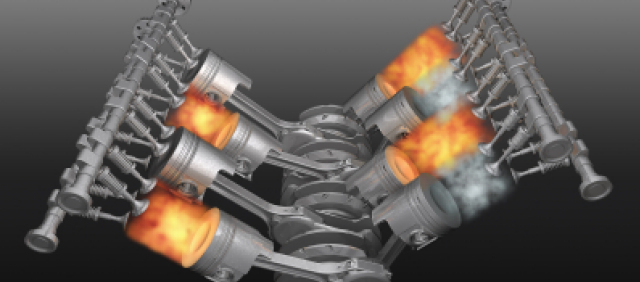
When the oil gets low, we pop the hood, look for the small yellow cap, and pour in the quart. But do we ever look at the rest of what’s going on under the hood? If we venture a little farther than the oil cap, we might understand that the battery helps start the car. We might discover that the alternator recharges the battery while the car is running. We might fundamentally grasp that the transmission makes the gears switch. But, we're literally dancing around the main question:
what about that big engine right in the middle? The average American understands that by feeding the engine gasoline, it makes the wheels turn, but beyond that we get lost. In an effort to get rid of ignorance, below is a step-by-step description of how a standard engine works. Most engines in cars--diesels ignored--are four-stroke engines. This means that for every power stroke that the engine puts out, there are four strokes total that each of its pistons performs. A stroke is when the piston moves from one end of the cylinder to the other, either up or down. In a four cylinder engine, there are four pistons, each performing four strokes per power stroke. The first stroke of the piston is often called the intake stroke because the piston goes to its downward position, allowing a maximum amount of room in the cylinder. Simultaneously, the inlet valve opens and allows a mixture of the car's gasoline and air to enter the cylinder. The inlet valve then closes, trapping the vaporized fuel inside the cylinder. The second stroke is known as the compression stroke. The piston goes from its full downward position to its full upward position. Because both the intake valve and the exhaust valve remain closed during this stroke, this movement causes the trapped fuel to compress and increase in pressure, temperature, and density. The fuel is now primed to create power. The third stroke is the power stroke. When the fuel is completely pressurized, a small spark is created which ignites the fuel and causes a controlled explosion. The power from the explosion causes several things to happen. First, power is transmitted to the crank shaft which turns the wheels. Secondly, it propels the piston downward and on to the fourth stroke with sufficient power to make it make through the cycle to the next power stroke. Thus, an engine with a consistent supply of gasoline and air is basically a self-sustaining machine. The fourth stroke is called the exhaust stroke. The exhaust valve opens as the piston moves, once again, from its downward position to its upward position. The gas left over from the explosion is forced out through the tailpipe, and the cylinder is once again ready to receive fuel during its next stroke, the intake stroke. The internal combustion engine revolutionized the way man did hundreds if not thousands of tasks, not the least of which is providing propulsion for the automobile. The next time you're adding oil, pause to appreciate the engine. And don't forget to schedule time to change the oil and tune up that engine to keep it healthy!
Call us today: Book An Appointment
Book An Appointment